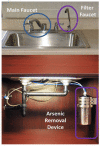Implementing a Community-Led Arsenic Mitigation Intervention for Private Well Users in American Indian Communities: A Qualitative Evaluation of the Strong Heart Water Study Program
- PMID: 36768048
- PMCID: PMC9915175
- DOI: 10.3390/ijerph20032681
Implementing a Community-Led Arsenic Mitigation Intervention for Private Well Users in American Indian Communities: A Qualitative Evaluation of the Strong Heart Water Study Program
Abstract
Arsenic is a naturally occurring toxicant in groundwater, which increases cancer and cardiovascular disease risk. American Indian populations are disproportionately exposed to arsenic in drinking water. The Strong Heart Water Study (SHWS), through a community-centered approach for intervention development and implementation, delivered an arsenic mitigation program for private well users in American Indian communities. The SHWS program comprised community-led water arsenic testing, point-of-use arsenic filter installation, and a mobile health program to promote sustained filter use and maintenance (i.e., changing the filter cartridge). Half of enrolled households received additional in-person behavior change communication and videos. Our objectives for this study were to assess successes, barriers, and facilitators in the implementation, use, and maintenance of the program among implementers and recipients. We conducted 45 semi-structured interviews with implementers and SHWS program recipients. We analyzed barriers and facilitators using the Consolidated Framework for Implementation Research and the Risks, Attitudes, Norms, Abilities, and Self-regulation model. At the implementer level, facilitators included building rapport and trust between implementers and participating households. Barriers included the remoteness of households, coordinating with community plumbers for arsenic filter installation, and difficulty securing a local supplier for replacement filter cartridges. At the recipient level, facilitators included knowledge of the arsenic health risks, perceived effectiveness of the filter, and visual cues to promote habit formation. Barriers included attitudes towards water taste and temperature and inability to procure or install replacement filter cartridges. This study offers insights into the successes and challenges of implementing an arsenic mitigation program tailored to American Indian households, which can inform future programs in partnership with these and potentially similar affected communities. Our study suggests that building credibility and trust between implementers and participants is important for the success of arsenic mitigation programs.
Keywords: RANAS model; arsenic; consolidated framework for implementation research (CFIR); drinking water; process evaluation.
Conflict of interest statement
The authors declare no conflict of interest.
Figures
Similar articles
-
Effect of an Arsenic Mitigation Program on Arsenic Exposure in American Indian Communities: A Cluster Randomized Controlled Trial of the Community-Led Strong Heart Water Study Program.Environ Health Perspect. 2024 Mar;132(3):37007. doi: 10.1289/EHP12548. Epub 2024 Mar 27. Environ Health Perspect. 2024. PMID: 38534131 Free PMC article. Clinical Trial.
-
Evaluation of a water arsenic filter in a participatory intervention to reduce arsenic exposure in American Indian communities: The Strong Heart Water Study.Sci Total Environ. 2023 Mar 1;862:160217. doi: 10.1016/j.scitotenv.2022.160217. Epub 2022 Nov 19. Sci Total Environ. 2023. PMID: 36410482 Free PMC article. Clinical Trial.
-
Behavioral determinants of arsenic-safe water use among Great Plains Indian Nation private well users: results from the Community-Led Strong Heart Water Study Arsenic Mitigation Program.Environ Health. 2023 May 15;22(1):42. doi: 10.1186/s12940-023-00965-0. Environ Health. 2023. PMID: 37183246 Free PMC article. Clinical Trial.
-
Lessons Learned from Arsenic Mitigation among Private Well Households.Curr Environ Health Rep. 2017 Sep;4(3):373-382. doi: 10.1007/s40572-017-0157-9. Curr Environ Health Rep. 2017. PMID: 28741248 Free PMC article. Review.
-
Arsenic in private drinking water wells: an assessment of jurisdictional regulations and guidelines for risk remediation in North America.J Water Health. 2014 Sep;12(3):372-92. doi: 10.2166/wh.2014.054. J Water Health. 2014. PMID: 25252340 Review.
Cited by
-
Intersectionality and Social Drivers of Health in Cardiovascular Care.Methodist Debakey Cardiovasc J. 2024 Nov 5;20(5):98-110. doi: 10.14797/mdcvj.1436. eCollection 2024. Methodist Debakey Cardiovasc J. 2024. PMID: 39525384 Free PMC article. Review.
-
Arsenic Exposure in Well Water From the Perspective of Patients and Providers.J Prim Care Community Health. 2024 Jan-Dec;15:21501319241247984. doi: 10.1177/21501319241247984. J Prim Care Community Health. 2024. PMID: 38682480 Free PMC article.
-
Effect of an Arsenic Mitigation Program on Arsenic Exposure in American Indian Communities: A Cluster Randomized Controlled Trial of the Community-Led Strong Heart Water Study Program.Environ Health Perspect. 2024 Mar;132(3):37007. doi: 10.1289/EHP12548. Epub 2024 Mar 27. Environ Health Perspect. 2024. PMID: 38534131 Free PMC article. Clinical Trial.
References
-
- Carlin D.J., Naujokas M.F., Bradham K.D., Cowden J., Heacock M., Henry H.F., Lee J.S., Thomas D.J., Thompson C., Tokar E.J., et al. Arsenic and Environmental Health: State of the Science and Future Research Opportunities. Environ. Health Perspect. 2015;124:890–899. doi: 10.1289/ehp.1510209. - DOI - PMC - PubMed
-
- United States Environmental Protection Agency . Drinking Water Requirements for States and Public Water Systems—Arsenic Rule. EPA; Washington, DC, USA: 2001.
Publication types
MeSH terms
Substances
Grants and funding
LinkOut - more resources
Full Text Sources
Medical



